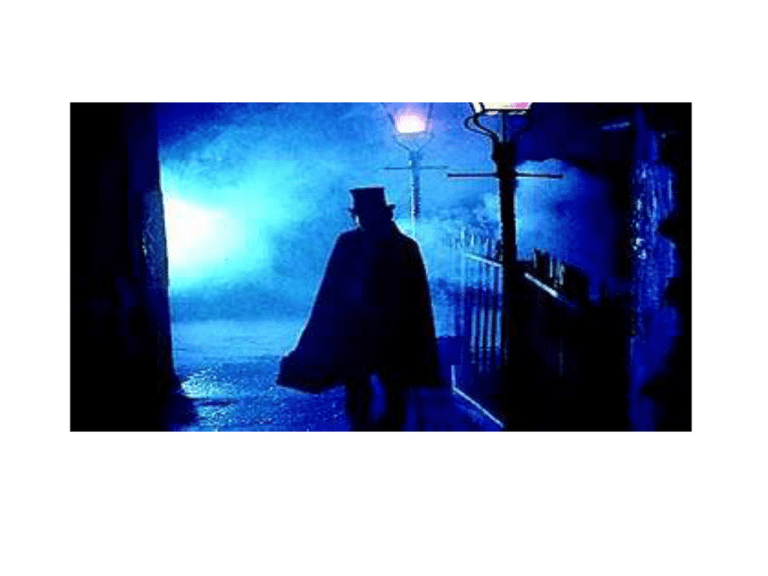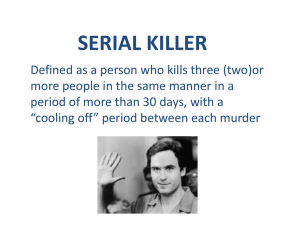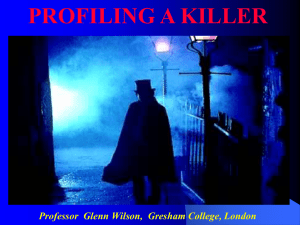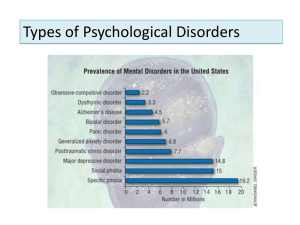
Definitions
Serial killer: A person who kills three or more
people in three or more separate events over a
period of time including an "emotional coolingoff" period in between the homicides (FBI
definition)
Mass Murder: The USA Bureau of Justice
Statistics defines a mass murder as "[involving]
the murder of four or more victims at one
location, within one event
The Serial Murderer: A General
Profile
• One of the most disturbing features of the phenomenon
of serial killing is that the murderers themselves seem
rather ordinary -- at least on the surface.
• Often of average height, weight and appearance.
• They can seem calm and reasonable, polite and friendly
• Most are of good intelligence, though few are educated
beyond high school or vocational school
• Usually middle- to lower-middle class
The Serial Murderer: A General
Profile
• The great majority of serial killers are
Caucasian and male.
• A small fraction have been women.
• About ten percent of serial murderers have
been African American, although their
numbers seem to be growing.
• Between two to three percent have been
Latino, Asian, or Native American.
The Serial Murderer: A General
Profile
• The thinking of these offenders is
dominated by violent, sexualized fantasies
of revenge and control, which often start in
childhood.
• Emotionally, they are characterized by
deep-seated frustration, fear, hostility,
anger, lack of self-esteem, and
depression.
• Many are loners and self-preoccupied.
John Wayne Gacy
Defining Serial Murder
• Serial murders are generally viewed by
law enforcement to be sexual homicides
• Some argue that serial murderers should
include any offenders, male or female,
who kill repeatedly over time
Defining Serial Murder: The
Number of Serial Killers
• The FBI estimates the number of
offenders in any given year to be thirtyfive, though it may be as high as 100 -- or
even more
• The number of identified serial killers has
surged since the late-1960s
The Number of Serial Killers
Difficult to determine due in part to:
Serial murderers are often active for a
period of a year or more.
The pattern linking individual homicides
may not be apparent at first to law
enforcement.
The killings may occur in several different
legal jurisdictions, which may hamper
efforts at detection
Categorizing Serial Murders and
Murderers
The FBI identifies serial killers as:
“Organized" (those who carefully plan
and execute their murders)
or
“Disorganized" (those who kill
spontaneously).
Categorizing Serial Murders and
Murderers
Other classifications are based on psychology, motive, or behavior.
One typology divides serial killers into four "types":
Visionary - responding to voices or visions
Mission-oriented - those who see themselves as
ridding society of certain groups, such as prostitutes or
the elderly
Hedonistic - those who derive some form of pleasure
(particularly sexual) from killing
Power or control-oriented - whose primary source of
pleasure is not sexual, but the ability to control and exert
power over a helpless victim
Categorizing the Killers:
The Organized Killer
The hardest to catch.
Socially adept
Average in appearance, height, and
weight
Dresses neatly
Prefers to use verbal means -- rather than
force -- to capture his victims and very
often succeeds.
Categorizing the Killers:
The Organized Killer
Methodically planned murders
A sexual sadist whose main goal is to gain
control over his victim through rape, other sexual
assaults, and eventually murder.
Control over the victim is seen in the use of
restraints, including rope, chains, tape, belts,
handcuffs, chemicals, gags, and blindfolds.
Fantasy and ritual predominate in the organized
offender.
Categorizing the Killers:
The Organized Killer
Obsessive, compulsive traits surface in the
commission of the crime.
The killer carefully avoids leaving evidence
behind and often moves the body from the
death scene.
During the commission of his crimes, he
reports being calm and relaxed.
Categorizing the Killers:
The Organized Killer
Comes from a relatively stable, lowerincome family and is often the firstborn
son
Inconsistent parental supervision.
Usually better-than-average intelligence,
sexually active, and lives with a partner.
Follows the investigation of his crimes in
the media.
Ted Bundy
Categorizing the Killers:
The Disorganized Killer
Typically, the disorganized offender:
• Is preoccupied with recurring obsessive thoughts
• Seems confused and distressed at the time of the crime.
• Fearful of people and has developed a highly-defined
delusional system.
• Acts impulsively under stress.
• Is of below average intelligence and has a poor history of
work.
• Frequently lives alone or with a parental figure and lives
in close proximity to the site of his murders.
• Is socially inadequate and often incompetent sexually.
• May have pronounced sexual aversions.
Categorizing the Killers:
The Disorganized Killer
The disorganized offender:
• Commits crimes suddenly
• Leave the crime scene in great disarray; it has a
spontaneous, symbolic, unplanned quality
• Generally, kills quickly in order to have control, catching
the victim completely off guard.
• Depersonalizes the victim and specific areas of the body
are targeted for extreme brutality. Overkill (the infliction
of more injury than necessary to kill) and mutilation of
the face are common.
• Generally performs sexual acts after death. These may
include mutilation of the genitals and breasts,
disembowelment, vampirism, or substitute sex acts such
as the insertion of objects into the victim's body cavities.
Richard Trenton Chase
Categorizing the Killers:
Team Killers
• Over one third of all serial murders are
committed by teams
• Most involve two offenders, and some groups
have as many as five
• One third of all team murderers are legally or
blood-related (siblings, husbands and wives,
lovers, even parents and their children)
• Women make up thirty-eight percent of these
groups.
• Eleven percent have been African American
Categorizing the Killers:
Team Killers
Examples:
• Kenneth Bianchi and Angelo Buono's
"Hillside Stranglers"
• Henry Lee Lucas and Otis Toole
• Douglas Clark and Carol Bundy
• Charles Manson and his "Family."
Categorizing the Killers:
Team Killers
Without exception, every group of
offenders has one person who maintains
control of the other members, whether
through coercion, intimidation, or other
persuasive techniques. Nearly all of these
"leaders" are men. Although women are
frequently involved with serial murder
teams, they generally are not the decisionmakers or main enforcers.
Categorizing the Killers:
Team Killers
At what point does a person agree to murder
victims? What enables someone to convince
others to murder? It seems unlikely that some
male and female offenders would ever have
committed these crimes if they had not been
exposed to group dynamics and the power of
persuasion and manipulation. Some people who
led groups of team offenders experienced a
sense of power and gratification not only through
the deaths of victims but also through getting
others to do their bidding.
Ian Brady & Myra Hindle
Categorizing the Killers:
Female Serial Killers
• Women represent only a small fraction of
the total number of serial murderers who
have been apprehended
• Since the 1970s there has been a notable
increase in the number of female serial
killers
Categorizing the Killers:
Female Serial Killers
• Female serial murderers are usually white
• They are generally older when they start
killing and tend to keep active over a
longer time.
• They are as likely to kill within their
families as they are to kill strangers.
• When killing within the family, husbands
are their primary victims
• Twelve percent kill children only
Categorizing the Killers:
Female Serial Killers
The majority of these killers fall into two
categories:
• “Black widows"
Women who kill their husbands, children, or
other relatives.
• Nurses and caretakers
Victimize people over whom they have control
Elderly men and women, and especially
babies, are their primary targets.
Categorizing the Killers:
Female Serial Killers
• Women do not, as a rule, sexually assault their
victims.
• Fantasy may play a role in their murders
• Female serial killers are generally less violent
than male serial killers.
• Nearly half of female serial killers poison their
victims
• Although some women do commit the brutal acts
more commonly associated with serial murder, it
is usually when working in tandem with men.
Aileen Wuormos
Categorizing the Killers:
Roaming Serial Killers
• Only a minority of serial murderers travel widely in
committing their crimes
• Half of all male serial killers are so-called "local"
offenders, staying within the general area of their cities
or counties and never carrying on their killing in more
than one state
• Twenty percent of serial murderers are "place-specific,"
using their homes or places of employment as killing
sites.
• Less than one third kill victims in more than one state
• Female serial killers are predominantly place-specific
• early half of all victims were murdered by local killers
Pedro Lopez
Family History and Childhood
Trauma
• Childhood poverty was not a factor for most serial
murderers. The majority of them report growing up in
homes with stable, if modest, incomes.
• Over three quarters of convicted serial killers come from
families with histories of alcohol and drug abuse.
• Over half had family histories of psychiatric disorders
• Half of their families had members who were involved
with criminal activities, from selling drugs to murder.
These were homes characterized by violence and
neglect.
• Nearly all offenders experienced a high level of physical
and psychological abuse from their parents and older
relatives.
Family History and Childhood
Trauma
• A majority were sexually abused as children, often by
members of their families.
• Many were subjected to strict discipline and humiliating
punishment.
• Seventy percent had to undergo psychiatric evaluation or
confinement as children and teens.
• These troubled homes were further disrupted by divorce
or separation and often by re-marriage.
• One third of these offenders grew up in a single location.
• Forty percent of serial murderers had lived outside of
their family homes before the age of 18 -- in foster
homes, state homes, detention centers, or mental
institutions.
Charles Manson
Childhood Behavior
Common attitudes and behaviors of children who grow up
to be serial murderers are:
• Rebelliousness
• Aggression
• Assaultive actions towards adults
• Chronic lying
• Daydreaming
• A sense of privilege or entitlement
• Compulsive masturbation and other autoerotic activities
are also commonplace. These behaviors intensify with
adolescence and ultimately become habitual by
adulthood.
Childhood Behavior
Cruelty towards animals and other children
often sets the stage for greater
abusiveness in the future.
Arson and bedwetting -- when seen in
combination with expressions of cruelty
are believed by some experts to be crucial
contributors to the development of a serial
murderer.
Henry Lee Lucas
Sexual Fetishes
Fetishism is the finding of sexual gratification through
substituting objects for a sexual partner.
• In one survey of convicted serial murderers, seventy-two
percent report having sexual fetishes.
• As young boys, many adult serial murderers report
having had strong attraction to high-heeled shoes,
female underwear, and rope. As adolescents and into
adulthood, they take repeated sexual interest in these
items. Eventually, these objects become part of the
ritualized aspects of their murders.
• Some offenders remove the breasts of their victims and
keep them as fetish objects. Others keep hair, teeth,
heads, fingers, and sexual organs.
Jerome Brudos
Committing Serial Murder: The
Role of Fantasy
• For both the organized and disorganized
serial murderer, early fantasies combining
violence and sex become more elaborate
with time.
• By adulthood, they are the central feature
of his life, the means through which he
encounters the world and validates his
own actions.
Committing Serial Murder: The
Role of Fantasy
• For the serial murderer, early fantasies
combining violence and sex become more
elaborate with time. By adulthood, they are
the central feature of his life, the means
through which he encounters the world
and validates his own actions.









